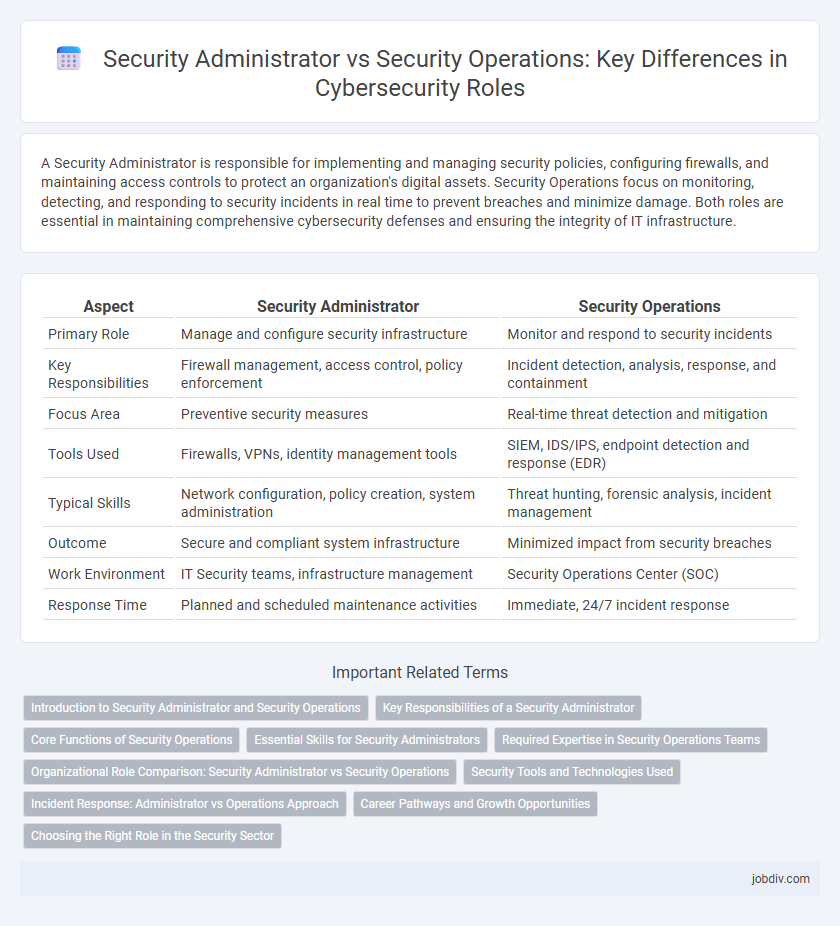A Security Administrator is responsible for implementing and managing security policies, configuring firewalls, and maintaining access controls to protect an organization's digital assets. Security Operations focus on monitoring, detecting, and responding to security incidents in real time to prevent breaches and minimize damage. Both roles are essential in maintaining comprehensive cybersecurity defenses and ensuring the integrity of IT infrastructure.
Table of Comparison
| Aspect | Security Administrator | Security Operations |
|---|---|---|
| Primary Role | Manage and configure security infrastructure | Monitor and respond to security incidents |
| Key Responsibilities | Firewall management, access control, policy enforcement | Incident detection, analysis, response, and containment |
| Focus Area | Preventive security measures | Real-time threat detection and mitigation |
| Tools Used | Firewalls, VPNs, identity management tools | SIEM, IDS/IPS, endpoint detection and response (EDR) |
| Typical Skills | Network configuration, policy creation, system administration | Threat hunting, forensic analysis, incident management |
| Outcome | Secure and compliant system infrastructure | Minimized impact from security breaches |
| Work Environment | IT Security teams, infrastructure management | Security Operations Center (SOC) |
| Response Time | Planned and scheduled maintenance activities | Immediate, 24/7 incident response |
Introduction to Security Administrator and Security Operations
A Security Administrator manages the deployment, maintenance, and configuration of security systems including firewalls, antivirus software, and access controls to protect an organization's network infrastructure. Security Operations involve real-time monitoring, incident detection, and response through a Security Operations Center (SOC), utilizing tools like Security Information and Event Management (SIEM) systems. Both roles are critical in creating a layered defense strategy, with administrators establishing security protocols and operations teams ensuring continuous threat mitigation.
Key Responsibilities of a Security Administrator
Security Administrators are responsible for implementing and managing an organization's security policies, configuring firewalls, and maintaining access controls to protect sensitive data. They perform regular system audits, monitor network traffic for suspicious activity, and ensure compliance with industry regulations such as GDPR and HIPAA. Their role is critical in vulnerability management, incident response coordination, and maintaining security infrastructure to prevent cyber threats.
Core Functions of Security Operations
Security Operations centers on continuous monitoring, incident response, and threat analysis to protect organizational assets from cyber threats. Core functions include real-time detection of security breaches, managing security information and event management (SIEM) systems, and coordinating with IT teams to implement mitigation strategies. Security Operations teams also conduct vulnerability assessments and maintain up-to-date defenses against evolving attack vectors.
Essential Skills for Security Administrators
Security Administrators require a deep understanding of network protocols, firewall management, and intrusion detection systems to effectively safeguard organizational assets. Proficiency in malware analysis, vulnerability assessment, and patch management is essential to prevent security breaches. Strong skills in access control, incident response coordination, and compliance with security policies ensure continuous protection and risk mitigation.
Required Expertise in Security Operations Teams
Security Operations teams require expertise in real-time threat monitoring, incident detection, and rapid response protocols to protect organizational assets effectively. Knowledge of Security Information and Event Management (SIEM) tools, network forensics, and malware analysis is critical for identifying and mitigating sophisticated cyber threats. Advanced skills in automation, scripting, and understanding of compliance frameworks enhance the team's ability to maintain robust security postures.
Organizational Role Comparison: Security Administrator vs Security Operations
Security Administrators primarily manage and configure security tools, enforce policies, and maintain system integrity to protect organizational assets. Security Operations teams focus on real-time monitoring, incident detection, and response coordination to mitigate ongoing threats across the network. The organizational role comparison highlights that Security Administrators ensure preventative measures and compliance, whereas Security Operations emphasize active threat management and rapid incident resolution.
Security Tools and Technologies Used
Security Administrators primarily manage and configure security tools such as firewalls, intrusion detection systems (IDS), antivirus software, and access control mechanisms to enforce organizational security policies. Security Operations teams specialize in continuous monitoring and incident response using Security Information and Event Management (SIEM) platforms, threat intelligence feeds, and automated incident detection technologies to identify and mitigate emerging threats in real time. Both roles rely heavily on complementary security technologies like endpoint detection and response (EDR) solutions and vulnerability management tools to maintain a robust cybersecurity posture.
Incident Response: Administrator vs Operations Approach
Security Administrators focus on establishing robust policies, configuring security tools, and maintaining system integrity to prevent incidents, whereas Security Operations teams prioritize real-time monitoring, detection, and rapid incident response to mitigate ongoing threats. Incident response handled by Security Administrators involves pre-incident preparation and post-incident analysis, while Security Operations execute immediate containment, eradication, and recovery actions during live security events. Both roles are critical for comprehensive incident management but differ in their approach: administrators emphasize strategic defenses, operations emphasize tactical execution.
Career Pathways and Growth Opportunities
Security Administrators focus on managing and maintaining an organization's security infrastructure, with career growth moving towards senior system administrators or security architects. Security Operations professionals specialize in real-time monitoring, incident response, and threat analysis, often advancing to roles like incident responders or SOC managers. Both career pathways offer opportunities to develop expertise in cybersecurity frameworks, risk management, and advanced security technologies, supporting upward mobility in the cybersecurity field.
Choosing the Right Role in the Security Sector
Security Administrators manage and maintain an organization's security infrastructure, focusing on system configuration, access control, and policy enforcement to prevent breaches. Security Operations teams monitor real-time threats, respond to incidents, and perform continuous threat analysis to protect assets from evolving cyberattacks. Choosing the right role depends on a preference for proactive system management versus dynamic threat detection and rapid incident response in the cybersecurity landscape.
Security Administrator vs Security Operations Infographic

 jobdiv.com
jobdiv.com